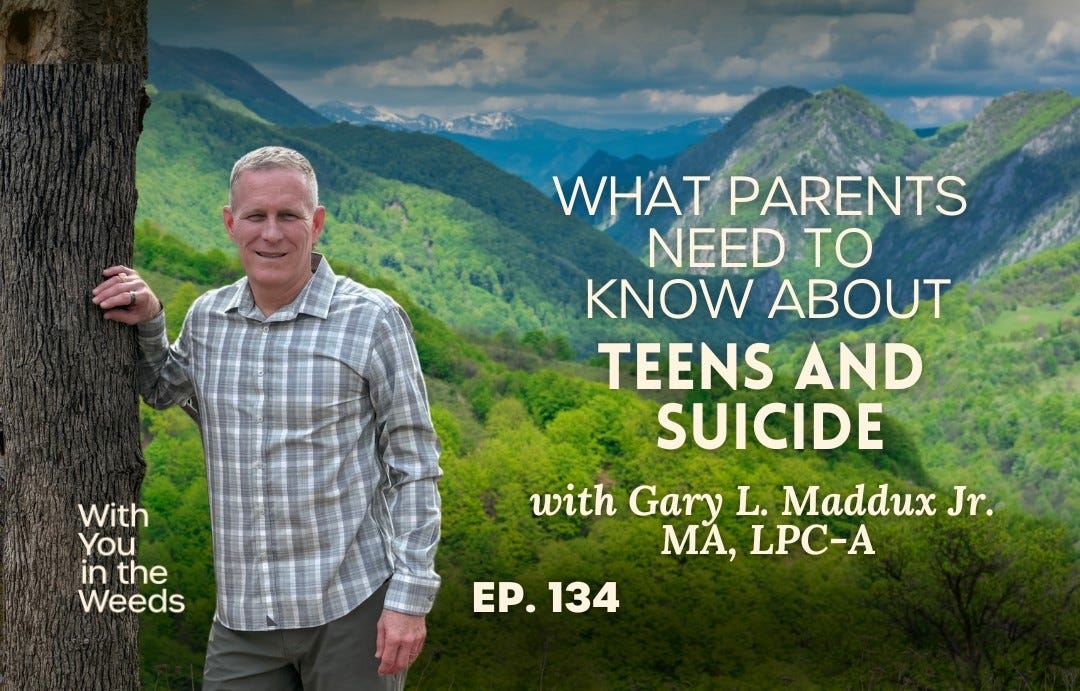What Parents Need to Know About Teens & Suicide
Prevention is possible
Has your child ever expressed a wish to end their life? Maybe you’ve noticed behavioral changes, like irritability and moodiness. Or worse yet – you stumble upon journal entries that indicate your child has suicidal ideation.
What should you do? What should you say?
In this heart-wrenching yet informative episode, Austin interviews Gary Maddux, a licensed counselor who works with patients struggling with depression and suicidal thoughts, as well as those who have lost loved ones to suicide and are working their way out of the deep well of guilt and grief.
But Gary isn’t just a professional with wisdom and experience. He’s also a father and husband who has walked this road personally. His daughter, Kaylee, died by suicide six years ago.
Listen in to hear more about:
Gary’s personal story of losing his daughter to suicide
Debunking myths about suicide and depression
Individual and relational dynamics that contribute to suicidal thoughts and behaviors
Practical ways to respond to suicidal ideation with care and compassion
Gary’s story is a reminder that Jesus’ presence is constant - even in the worst tragedy - and that God embraces those who are impacted by suicide. You will feel more equipped to navigate this heavy topic after learning how to offer care and compassion to your loved ones who are struggling.
Highlights of Austin’s Conversation with Gary
Our guest, Gary Maddux, is well-qualified to address this timely but difficult topic. He has a Master’s in Clinical Mental Health Counseling, worked as a crisis text line counselor, leads suicide loss survivor groups, and is an expert in the QPR method of suicide prevention (question, persuade, refer). We’re so glad to welcome him to WYITW to share his personal story and professional wisdom.
Gary’s Story
My wife of 36 years and I have four children. So Kaylee had an older sister, a younger sister, and a younger brother. This loss was something that our family never saw coming. We never thought we would have a child die by suicide. We don’t like to think about our children dying in any way, but I couldn’t fathom my daughter dying by suicide.
After my daughter's death, the only way that I knew how to heal was to get educated. After I went through the initial stages of overwhelming grief, loss, and pain, I wanted to figure out the “whys” and answer my questions. Initially I was searching for my own answers, but ultimately it became a calling to try and help families and individuals who are struggling with the effects of suicide.
When you lose someone to suicide, it’s always an untimely death – and it doesn’t occur in a natural way. You are losing someone when you never thought you would lose them. And everyone grieves that loss differently.
When you lose someone to suicide, it’s always an untimely death – and it doesn’t occur in a natural way. You are losing someone when you never thought you would lose them. And everyone grieves that loss differently.
The Mourning Journey
After Kaylee died, all five of us grieved in very different ways and had different needs. To me, grief is the overwhelming emotion that happens after we lose a person or a dream or something else important. Mourning is the process as we move forward in time because life continues to move forward. It’s a mourning journey.
As people move forward, they either integrate the loss into their lives or they don’t. And each person has a different way of doing that. For me, it was to learn, be part of a group, become a counselor. For my wife, the last thing she wanted to do was talk about it to others or be part of a group. She needed to do things for herself; self-care is very important after a loss like this.
Walking Stigma
Before Kaylee’s death, I was a “walking stigma” because I learned and believed all of the wrong things. My dad was a police officer, and I saw several of his friends die by suicide. I lost my cousin to suicide in college.
Throughout these experiences I learned from the words that were spoken to me – which was that people who die by suicide are weak, not courageous. They took the easy way out, they were selfish, they should have had more faith.
But then my daughter dies by suicide. What do I do with all the things I’ve thought? Now I teach people what suicide is and what it isn’t. And the old thoughts are not part of my vocabulary anymore. But I’m honest with people that this is what I used to think.
How to Use Statistics
I recommend caution with statistics. They are always very negative. You’ll rarely hear someone talk about how many healthcare providers help someone decide to not die by suicide. So focusing on them can lead to fear.
That said, it can help to know just how big a problem this is. Here are some statistics that show what we are dealing with:
The age-adjusted suicide rate was 14.21 per 100,000 individuals in 2022.
White males accounted for 68.46% of suicide deaths in 2022.
Firearms accounted for 54.64% of all suicide deaths in 2022.
1.6 million attempts in 2022.
What concerns me and where my focus is:
Suicide is the 3rd leading cause of death for ages 15-24
It’s the 2nd leading cause of death for ages 25-34
More veterans and first responders die by suicide than in the line of duty
Shattering 4 Myths About Suicide
Myth #1: Only experts can prevent a suicide.
Truth: Suicide is the end result of a terrible equation where negative variables stack. Anyone can affect the outcome and be a positive influence. When someone considers suicide, they don’t want to die – they just want to end the pain. You don’t need to be a professional to become a positive variable in that person’s life equation.
Myth #2: Talking about it causes people to consider it or it opens them up to risk.
Truth: Talking typically lowers anxiety and decreases impulsivity. If someone's thinking about suicide, they're already thinking about it, so you're not going to introduce the idea to them. If they're not thinking about it and they're honest with you, they're going to say, "I feel really sad and down and I'm hurting, but I would never think about killing myself."
If they’re thinking about it, you can have a conversation, get them help, and work through it together. And if they’re not thinking about it, you haven’t given them the idea.
Myth #3: Those who are thinking about suicide keep it to themselves.
Truth: There is a Welsh saying that “No great suffering is left unspoken”. Many people will talk about their depression and their suicidal ideation. But not everyone will. There can be other signs, especially in teens – changes in behavior, appetite, irritability, that kind of thing that can signal that something is wrong.
Myth #4: Those who talk about suicide will not kill themselves.
Truth: If someone is talking about it they may very well attempt or complete and you have to take it seriously. There can be times when someone says they are thinking of killing themselves and they don’t, and it may seem like they’re not serious. But you never know when they might cross the line and act.
Suicide Prevention
Often, suicidal ideation is paired with a sense of lost identity, relationships, passion, or purpose. The weight of these losses creates hopelessness that feels too heavy to overcome. My experience at the crisis text line was that over 90% of the young people were experiencing a relational crisis or loss of identity.
Children need the 4 S’s to thrive: to be seen, feel safe & secure, and learn to self-soothe in healthy ways. It’s crucial that parents provide those things to kids when they are growing up. Another thing that’s great to teach your kids is to live in the here and now – it can be tempting to dwell on mistakes and missed opportunities of the past (shame) or ruminate on the future (anxiety).
Consider becoming trained in QPR – question, persuade, refer. This method will help you be able to recognize the warning signs of suicide and question, persuade, and refer people at risk for suicide for help.
While prevention is possible, it’s not guaranteed. Even an expert can’t always keep someone from self-harm. The aim in learning about prevention is to decrease the risk of suicide and normalize conversations about it - but not to increase guilt. In each situation, the decision to attempt or complete suicide ultimately belongs to the individual.
Though it is tempting and normal to look for someone to blame in the face of suicide, it’s important to remember that even our best efforts may not be enough to convince someone to live who is convinced they want to die.
Though it is tempting and normal to look for someone to blame in the face of suicide, it’s important to remember that even our best efforts may not be enough to convince someone to live who is convinced they want to die.
What Parents Should Know About Suicide
Suicide is extremely complex – there is no single cause and each situation is unique. But the three common factors that are present in some amount are pain, hopelessness, and feeling like a burden to others. If these feelings aren’t shared, the person recedes into the echo chamber of their own mind and these feelings are strengthened until death seems to be the only way out.
Language is important. It helps shift our thoughts and perspective and helps those who are suffering. You can create or remove barriers with your words. One thing to change is to say, “died by” instead of “committed”. Committed implies a sin or a crime. Think about someone who is battling cancer to help with language. We don't say a person committed cancer!
Replace terms like “success” and “failure” with “they completed” or “they attempted and survived”. Don’t assume they died by suicide because of a specific event or challenge. Suicide is the result of a complex equation with many variables. Avoid saying they were weak, took the easy way out, they were selfish, or they were cowards.
Finding Jesus in Grief and Pain
If someone asks me, “Where is Jesus in all of this?”, I can answer with assurance, “Jesus is in everything.” After losing Kaylee, for the first time in my life, I was in a place where I couldn’t handle things on my own.
That was actually a good place for me to be because I had to lay it all down and give it to Jesus. That was the only choice that I had. I was brought to my knees in humility. That solidified my faith in a way that I can’t even describe – and opened up new pathways for me as I moved forward.
We are so thankful to Gary for sharing his story with honesty and vulnerability. Please take a look at the resources below if this is an issue you’re dealing with. And remember - you are not alone.
Recommended Resources:
QPR Training: Question, Persuade, Refer
ASK Suicide Prevention Training
National Suicide Lifeline: Call or text 988. Conversations are free and confidential.





